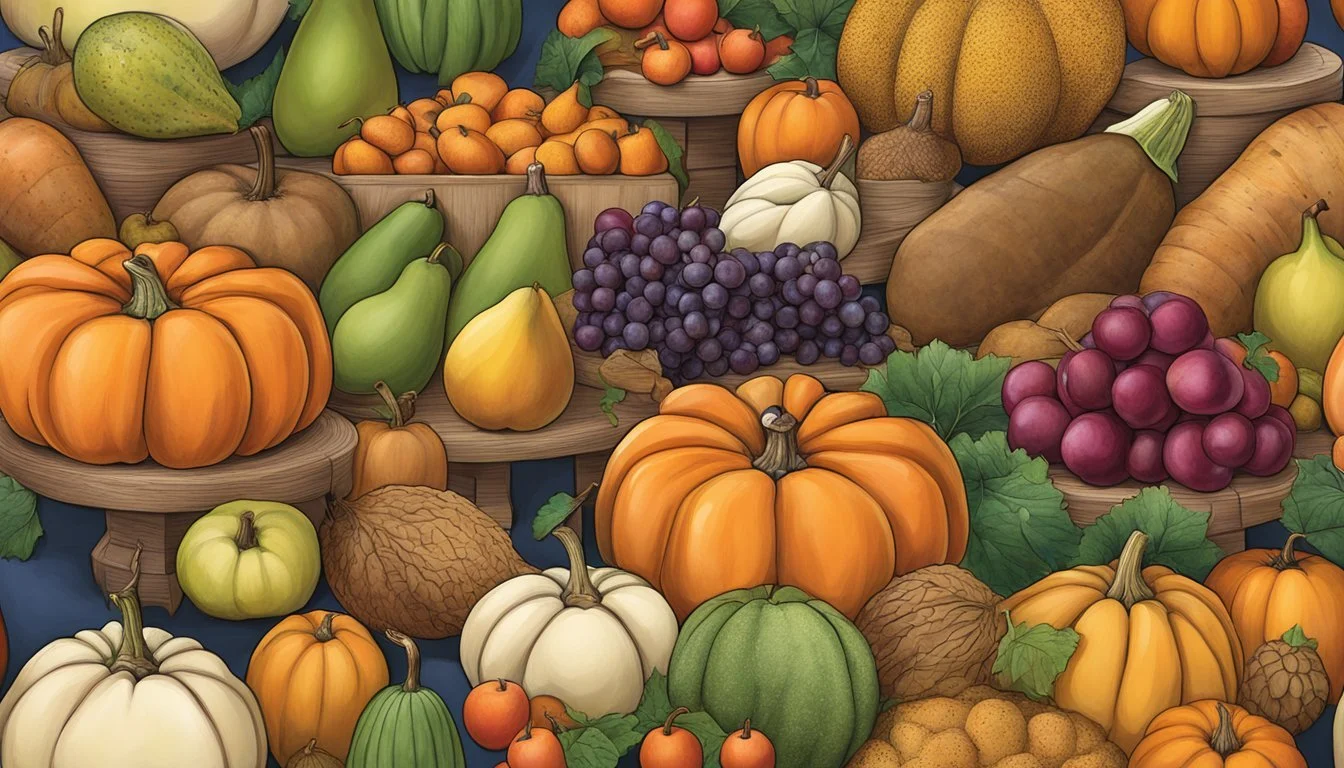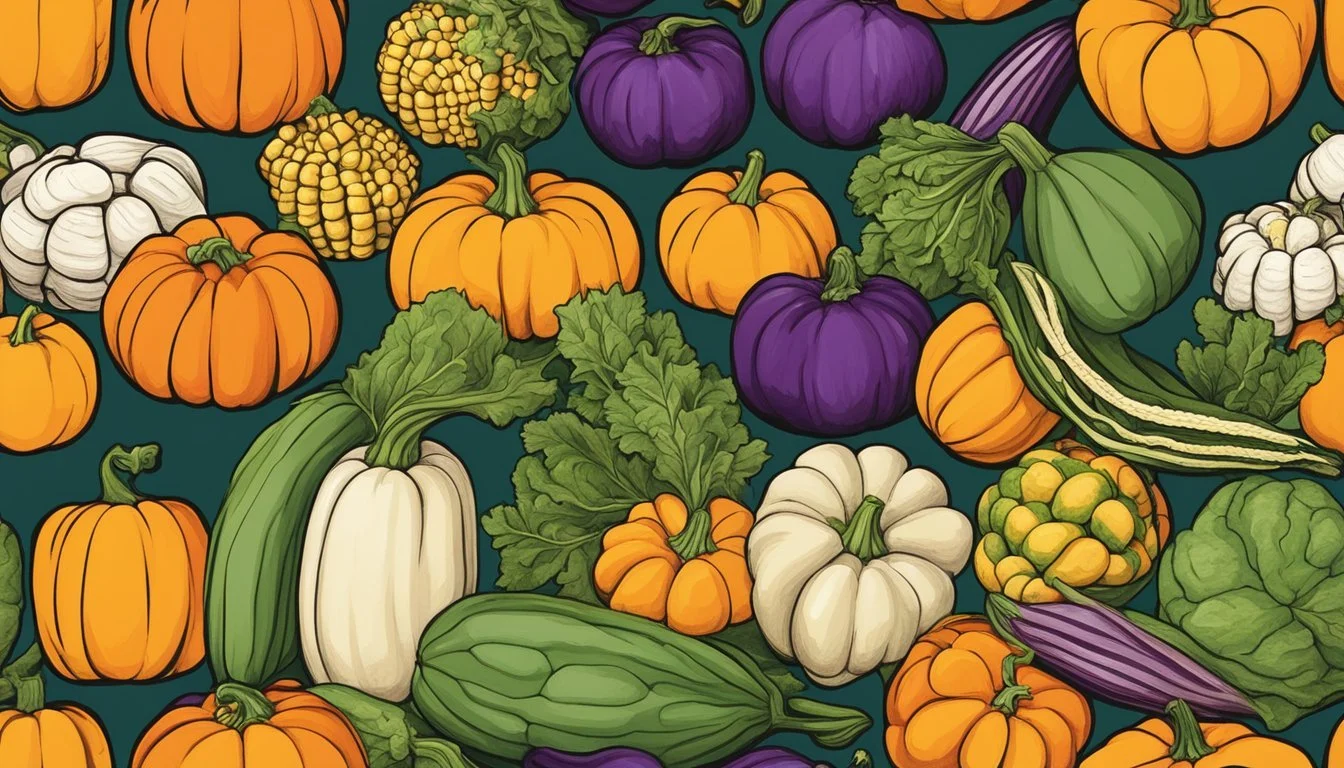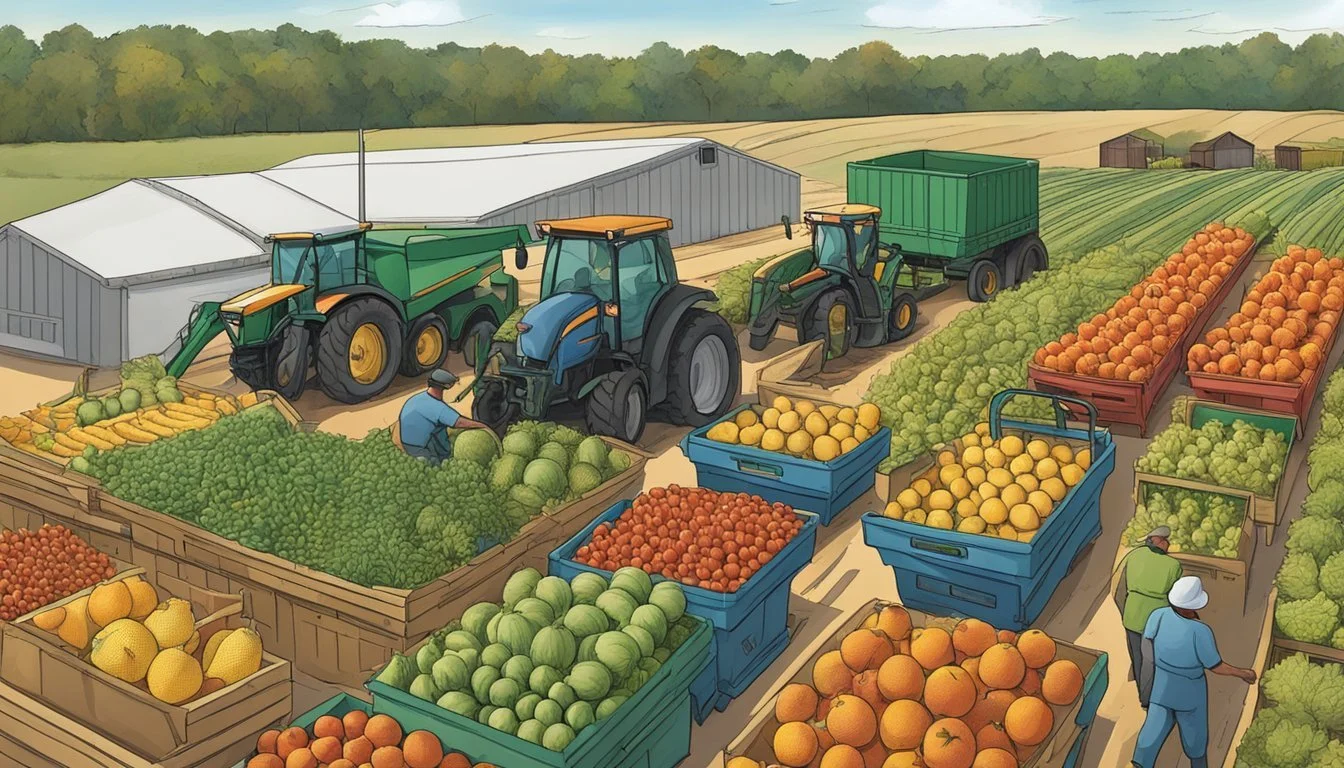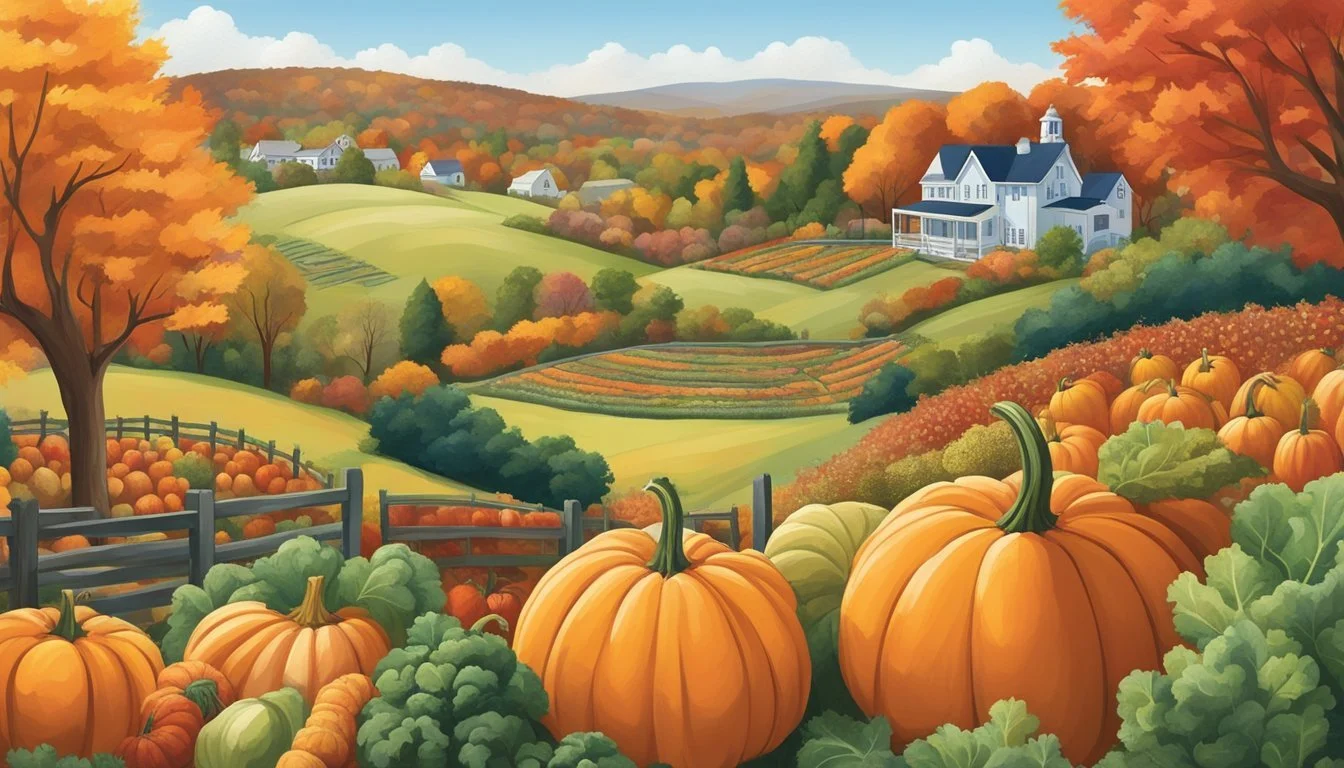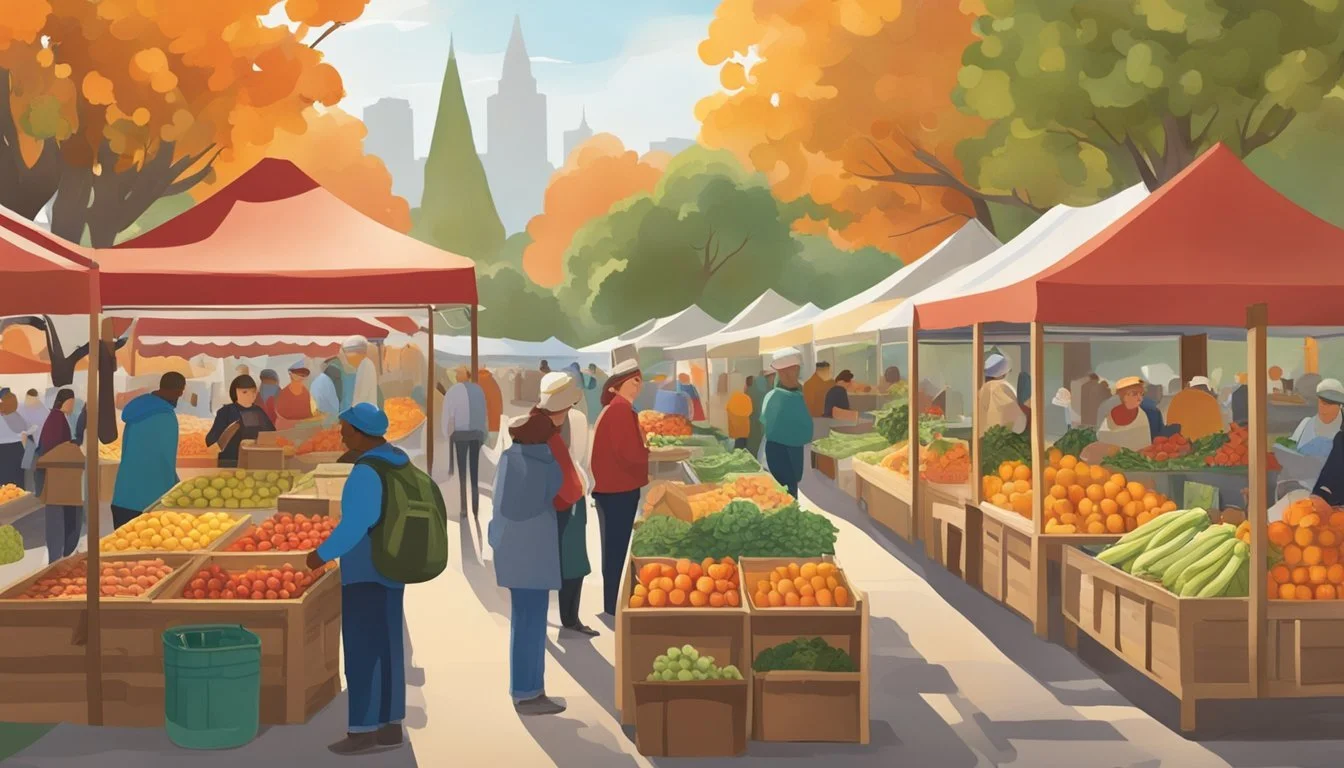Arkansas Seasonal Fruit & Vegetables in November
Your Guide to Fresh Produce
This Article is Part of our Arkansas Seasonal Fruit & Veg Calendar
November in Arkansas heralds a time of transition for the state's agriculture, marked by the end of the warm growing season and the start of cooler temperatures. Despite the chill setting in, the state’s climate – influenced by its diverse geography – and fertile soils still support the growth of a variety of produce. Farmers and home gardeners alike are busy harvesting the last of the fall crops while also preparing their fields and plots for winter.
The variety of fruits and vegetables available during this month is a testament to Arkansas's agricultural resilience. While the state's peak growing season has passed, there remain several crops that thrive in the November climate. The harvests during this time are not just about utility but also about enjoying the rich flavors and nutritional benefits of seasonal produce before winter fully sets in.
Overview of Arkansas' Climate and Soil
Arkansas' environment is characterized by a diverse climate, largely influenced by its geographical location in the southern United States. The state experiences a humid subtropical climate, with hot, humid summers and mild to cool winters. This climate type is conducive to growing a wide range of fruits and vegetables throughout the year.
Climate: The growing season in Arkansas typically extends from late March to late October, though this can fluctuate slightly depending on the region. The weather during these months is generally warm, ensuring a long and productive growing season.
Soil: Soils in Arkansas are varied but predominantly consist of fertile alluvial types along the river valleys and upland soils that are more rocky and acidic. Different regions have specific soil compositions:
Delta Regions: Rich, alluvial soils ideal for row crops and certain fruit production.
Ozarks & Ouachita Mountains: Rockier and well-drained soils, suitable for hardy fruits and vegetables.
Arkansas is divided into multiple hardiness zones, which range from zone 6a in the northern parts to 8a in the southern regions. This categorization helps gardeners and farmers determine which plants are most likely to thrive in their area based on the minimum temperatures.
Important Environmental Factors:
Average Temperature: Varies from north to south, with southern areas being warmer.
Precipitation: Evenly distributed throughout the year, with spring and early summer being the wettest seasons.
Sunlight: Most vegetables need at least six hours of direct sunlight.
Understanding Arkansas' climate and soil is important for working with the local agricultural calendar and promoting sustainable practices tailored to the state's unique growing conditions.
Seasonal Fruits in Arkansas
In November, Arkansas boasts a variety of fruits reaching the peak of their freshness and flavor. The harvest season is particularly notable for tree fruits such as apples (how long do apples last?) and pears, which are abundant during this month.
Apples and Pears
Arkansas's climate and soil produce a rich harvest of tree fruits in November. Specifically, apple trees yield a diverse selection of apples, each with its unique taste and texture. Varieties typically include Fuji, Granny Smith, and Arkansas Black, among others. Similarly, pears such as the Bartlett and Asian Pears also reach maturation and can be found fresh in the markets.
Apple Varieties
Fuji
Granny Smith
Arkansas Black
Pear Varieties
Bartlett
Asian Pears
Berries and Small Fruits
Although the berry season is winding down, one can still find remnants of late-harvest berries in Arkansas during early November. These fruits, which include persimmons often used in jams and preserves, are among the last of the small fruits to be picked before winter sets in.
Late-Harvest Fruits
Persimmons (for jam and fresh eating)
Citrus and Exotic Fruits
While Arkansas is not a traditional citrus-growing state, some hardy citrus like lemons may be available from indoor or sheltered growing environments. Additionally, Arkansas provides a climate suitable for pomegranates, which are typically harvested in the fall and are available into November.
Exotic and Citrus Fruits
Pomegranates
Cultivated Lemons (limited availability)
Seasonal Vegetables in Arkansas
November marks a bountiful period for Arkansas' seasonal produce, featuring a range of hearty vegetables well-suited to the cooler temperatures. Harvests during this time predominantly consist of nourishing root vegetables, robust leafy greens and brassicas, as well as a variety of winter squash.
Root Vegetables
Arkansas soil yields a rich harvest of root vegetables in November. These include:
Carrots: Sweet and crunchy, ideal for soups and stews.
Turnips: A versatile vegetable that can be mashed, roasted, or added to casseroles.
Potatoes: A staple in many dishes, ranging from roasted to boiled.
Radishes: Offering a peppery flavor to salads and perfect for pickling.
Parsnips: With a sweet, nutty flavor, parsnips are excellent in both savory and slightly sweet dishes.
Leafy Greens and Brassicas
The cooler temperatures provide perfect growing conditions for a variety of greens and brassicas:
Kale: Packed with nutrients, kale is a hearty green that can be used in salads, soups, and chips.
Brussels Sprouts: These mini cabbages grow sweeter with the frost, perfect for roasting.
Cabbage: Versatile in use, from slaws to sauerkraut.
Collards: Traditionally simmered with flavorings for a Southern dish.
Chard: With colorful stems, chard is as nutritious as it is visually appealing.
Broccoli: A cool-weather crop that thrives in Arkansas' climate, excellent for steaming or stir-frying.
Lettuce: Various types, including Romaine and Butterhead, continue to grow well during November.
Winter Squash Varieties
Several types of winter squash are ready for harvest in Arkansas during November:
Butternut Squash: (how long does butternut squash last?) Known for its sweet and nutty taste, it's commonly used for soups and purees.
Acorn Squash: With its distinct ridges, it's perfect for baking and stuffing.
Delicata: This squash has a creamy texture and can be roasted or stuffed without peeling due to its edible skin.
Pumpkin: Beyond carving, pumpkins are great for pies, soups, and roasting.
Arkansas' November produce offers flavors and nutrition that cater to a variety of tastes and cooking methods, with vegetables that are perfect for warming, seasonal dishes.
Harvest and Storage Tips
November in Arkansas brings with it a unique set of fruits and vegetables ready for harvest. Key to ensuring these crops both endure and maintain quality through their peak season involves understanding the correct techniques for harvesting and the best practices for storage.
Proper Harvesting Techniques
Fruits: When harvesting fruits such as apples or pears, one should be gentle to avoid bruising. Apples are ready when they separate easily from the tree with a slight twist. For fruits prone to pests or diseases, inspect and remove any diseased specimens promptly to avoid spreading.
Vegetables: Greens and root vegetables require careful attention during harvest. One should harvest greens early in the day to ensure they are crisp and full of moisture. For root vegetables, it's important to lift them gently from the soil to avoid damage. Inspection for pests and any signs of damage is crucial to avoid deterioration after harvesting.
Storing for Freshness
Fresh Fruit: Most fresh fruit should be stored in a cool, dark place. Some may require refrigeration to prolong freshness. Here’s how to store key November produce:
Apples: Store in a cool, humid place away from strong odors.
Pears: Store at room temperature until ripe then refrigerate.
Freezing: Freezing is an excellent option for preserving harvest surpluses. Vegetables should be blanched before freezing to preserve color, texture, and flavor. Fruits can be frozen whole or in slices, often with a sugar pack or syrup, to help retain their quality.
Canning: Another effective preservation method for Arkansas’s bounty is canning, suitable for many vegetables and fruits. Always use proper canning techniques to prevent spoilage and ensure safety.
Root Vegetables: Store in a cool, dark, and well-ventilated area, often with sand or soil to mimic underground conditions. For example, carrots and beets can be stored in a root cellar or similar environment for extended freshness.
Properly pruning plants during the growing season can prevent overtaxing resources and help control pests and diseases, leading to a bountiful harvest ready for effective storage. When vegetables and fruits are harvested and stored with care, they can provide a taste of Arkansas’s November harvest well into the winter months.
Preparing Seasonal Produce
With November's harvest, Arkansas offers a bounty of fruits and vegetables that can be transformed through cooking and preservation. Residents have the opportunity to savor the flavors of fall by incorporating squash, pumpkins, apples, and pears into their recipes or extending their shelf life through canning, freezing, and making jams or salsa.
Cooking and Baking
Fruits:
Apples: Arkansas apples can be baked into pies or crisps, providing a classic autumnal dessert.
Pears: They are excellent when poached or added to salads for a sweet, juicy crunch.
Vegetables:
Squash and Pumpkins: Squash can be roasted, turned into comforting soups, or stuffed. Pumpkins are also versatile, lending themselves well to both sweet pies and savory dishes.
Preservation Methods
Fruits:
To preserve these seasonal delights, fruits like apples and pears can be turned into preserves such as jams or can be canned as pie fillings for enjoyment throughout the year.
Vegetables:
Freezing: Squash and pumpkins can be pureed and frozen, perfect for use in future recipes.
Canning: Salsas and pickles are popular options for canning, which can include a variety of November vegetables, like pumpkins, to add a unique twist.
Gardening Tips for the Fall Months
As the fall months set in within Arkansas, gardeners should focus on garden maintenance and preparing for the colder weather. November's chill brings an array of garden chores geared towards protecting plants and ensuring a healthy garden for the following season.
Managing the Garden
In November, Arkansas gardeners need to prioritize garden insulation and disease prevention. Mulching is essential; a thick layer of mulch can protect plant roots from freezing temperatures and help conserve soil moisture. Raking fallen leaves and using them as mulch adds an extra layer of insulation and recycles valuable nutrients back into the garden.
The garden may still house pests and remnants of diseases that can overwinter. It's important to remove any diseased plant material and dispose of it properly, rather than composting, to prevent the spread of pathogens. One should also inspect the garden for pests that might be seeking shelter for the winter and remove them.
November Gardening Chores
In preparation for potential frost and snow, Arkansas gardeners should safeguard their plants. This includes:
Pruning: Light pruning can help remove dead or dying branches and prepare plants for next year's growth. However, heavy pruning should generally be avoided to prevent new growth that could be damaged by the cold.
Watering: Plants still need adequate hydration even in the cooler months, especially after a dry summer. One should water the garden deeply before a freeze to provide plants with the moisture they need.
Wrapping: Tender trees and shrubs may benefit from burlap wraps to shield them from harsh winds and frost.
By staying proactive with these November gardening chores, gardeners in Arkansas can ensure their gardens are well-maintained during the fall and well-prepared for the winter months ahead.
Arkansas Food Culture and Local Cuisine
Arkansas's culinary heritage reflects its geographical diversity and agricultural roots. The state is renowned for its plentiful produce, with greens and vegetables taking center stage in local dishes. Arkansas's food is characterized by the Southern tradition, heavily featuring farm-fresh ingredients.
Produce: Arkansas's soil and climates are conducive to a wide variety of seasonal produce, including an array of greens. Locally grown vegetables often make their way into regional specialties, underscoring the state's commitment to farm-to-table dining.
Local Cuisine: Dishes such as fried green tomatoes, collard greens, and hush puppies are staples in Arkansas's local cuisine. These southern comfort foods showcase the state’s agricultural offerings while offering a taste of traditional Southern cooking.
Restaurants: Eateries across Arkansas highlight local produce in their menus, serving both classic Southern fare and innovative dishes. Chefs in the state's restaurants are increasingly sourcing ingredients from local farms, ensuring freshness and supporting Arkansas's agricultural economy.
Arkansas's food culture is a reflection of its history and a testament to the state's rich agricultural environment. "The Natural State" continues to celebrate its heritage through the integration of home-grown produce in its local cuisine, whether in homes or restaurant settings.
Where to Buy Seasonal Produce
In November, Arkansas offers a variety of locations where individuals can purchase fresh, seasonal produce. These include farmers' markets and farm stands, as well as grocery stores and specialty shops.
Farmers' Markets and Farm Stands
Arkansas residents can find a bounty of seasonal fruits and vegetables at local farmers' markets and farm stands. Farmers' markets are communal spaces where multiple local farmers gather to sell their produce directly to consumers. These markets often feature a diverse array of local produce, showcasing the season's best from all participating vendors.
Locations: Farmers' markets are scattered throughout Arkansas, often found in city centers or community spaces.
Produce availability: Depending on harvest cycles, items like winter squash, sweet potatoes, and leafy greens may be available.
Community Supported Agriculture: Some farmers at these markets participate in Community Supported Agriculture (CSA) programs, where consumers can purchase a share of the harvest in advance.
Grocery Stores and Specialty Shops
Grocery stores and specialty shops in Arkansas also stock fresh fruit and vegetables, including seasonal local produce. While the selection may vary, many stores prioritize sourcing from nearby farms to offer the freshest options to their customers.
Local Produce Sections: Shoppers should look for dedicated sections highlighting local produce.
Green Markets: Some areas may host indoor green markets or specialty shops focusing on local and organic options.

